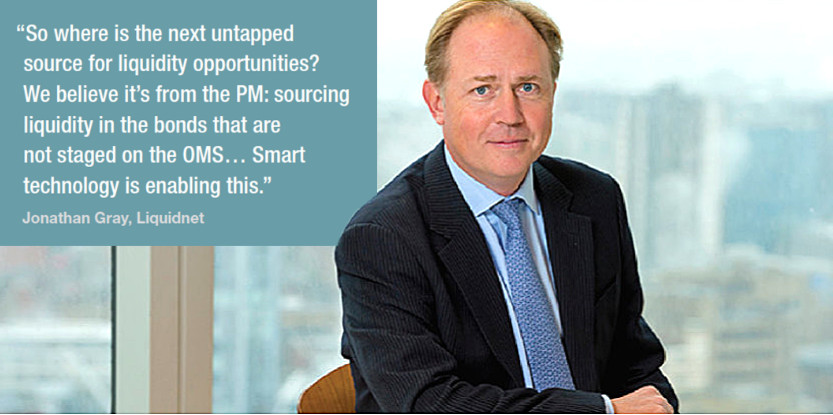Liquidity opportunities for the fixed income portfolio manager
Jonathan Gray, Head of Fixed Income EMEA, Liquidnet
The corporate bond market has changed dramatically in the last five years with electronic trading playing an increasingly important role in liquidity and price formation. The technology advances that have emerged so far, for the most part have been focused on enhancing the trader’s workflow. One could argue that it was about time, and empowering the trader to become a value-add part of the investment process is a worthwhile goal. But what about the portfolio manager (PM)? How can they become more involved in the liquidity ecosystem?

As traders continue to embrace new technologies that allow them to execute larger or more difficult to trade names, and to achieve best execution, in parallel the portfolio manager’s role is evolving, driven by their need for alpha generation from more sophisticated and differentiated tools. Recent developments in analytics, machine learning, and artificial intelligence have started to infiltrate trading applications and will also create opportunities for the portfolio manager which were previously untapped, or simply unavailable.
The liquidity final frontier
Since the financial crisis in 2008, many bonds have become harder to trade and the ability to buy or sell bonds with minimum market impact has weakened globally. The buy side are now established as significant providers of liquidity and they have the tools to successfully match, negotiate and trade anonymously with their buy-side peers. Now, when the markets are challenging, it need no longer be the case that liquidity dries up. In May of this year when the Italian BTP market became volatile, liquidity in some credit markets became harder to obtain. Asset managers reported bid/offer widening and RFQ responses were scarce. Yet buy-side institutions were able to find the liquidity they needed in venues such as Liquidnet, who evidenced the consistency of its model with record trading at this time and over $20bn in average daily liquidity. Why? Because the buy side realised that they were now one of the best sources for liquidity, and they looked to systems that would help centralise that liquidity and allow for efficient access. The buy side were prepared and able to plug that liquidity gap.
So where is the next untapped source for liquidity opportunities? We believe it’s from the PM: sourcing liquidity in the bonds that are not staged on the OMS, but that a PM is considering, and would be interested to trade if a contra was on the opposite side of their intention. Smart technology is enabling this. It can be as simple as a watchlist that is entered into an execution system, which then sends notifications of available liquidity – a buyer or seller showing an intention to trade in a targeted and protected way. Even more interesting is when a smart trading system can offer substitute liquidity, by way of a different bond in the same credit, or sector, which is then presented to a trader as a possible alternative. These innovative processes are available to fund managers today and result in a better liquidity picture being established in a certain credit or sector that the portfolio manager can incorporate alongside their investment ideas.
Removing the obstacles to trade
A number of trading desks have advanced beyond order execution to now playing a role in alpha generation by implementing investment strategies in consultation with their portfolio manager. However, for the PM, too often their investment ideas are becoming harder to execute due to current inefficiencies inherent in the fixed income market. Many of the research reports and tools historically available to fixed income PMs are losing their value, as they become more widely available, and often tend to reflect existing information with little capability for a unique perspective. The length of time it takes from idea generation to trade completion can mean a good idea never gets off the ground, negatively impacting alpha and overall portfolio returns. Using a peer-to-peer trading platform that enables portfolio managers to exchange liquidity ideas with each other and understand, in a protected environment, where supply and demand is, could go some way to increase the likelihood that more of the best investment ideas see the light of day.
In early 2017, in collaboration with its community of traders, Liquidnet incorporated a portfolio manager component to its fixed income platform that is now being used by more than 35 portfolio managers. Supported by the latest technology, portfolio managers are interacting directly with the platform that allows them to create and assign indications to their trading desk, sourcing liquidity that previously the traders wouldn’t have had visibility into. This is Indication of Interest (IOI) sharing amongst the buy side that limits the problem of information leakage and price diminution that might arise with the traditional method of trading by phone, as trading intentions no longer need to be socialised. Essentially this facilitates size discovery without price destruction.
Amplifying differentiation
New workflow tools are bringing the portfolio manager more insight and can even enhance their interactions with the trading desk. Although the analysis, experience, and judgment of the individual portfolio manager will always be important, there is more potential for differentiation. They can also be empowered with a combination of traditional and alternative data sets, AI driven predictive analytics, market signals and alerts – not available in plain sight.
These tools can then arm the portfolio manager of the future with a more complete picture of the investment thesis and, in partnership with the trader, enable the use of technology for additional alpha generation.
©Markets Media Europe 2025












